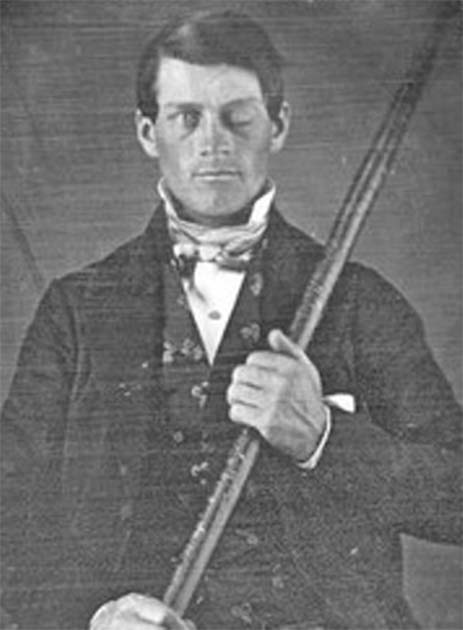The story of Phineas Gage is taught in almost every psychology and neurology course in school, and his story has interested people since the day it happened. Known for having an iron rod blasted into his head and surviving, Gage has been considered a significant development in scientific knowledge of the brain and human behavior.
Everyone has at least heard of his personality change after his traumatic brain injury, but the story that grosses us out as much as it fascinates us is not as accurate as we believe. What was the truth about Phineas Gage?
Phineas P. Gage
Phineas P. Gage was born in 1823 in Grafton County, New Hampshire, and he had a normal, uneventful childhood. Not much is known about Phineas Gage before his accident.
Still, his physician, John Martyn Harlow, who treated Gage before and after his injury, described the man as “a perfectly healthy, strong, and active young man, twenty-five years of age… five feet six inches (1.68m) in height, average weight one hundred and fifty pounds (68kg), possessing an iron will… having had scarcely a day’s illness from his childhood to the date of injury.”

The life of Phineas Gage was changed forever on September 13, 1848, while he was leading and working with a crew blasting rock to create a roadway for the Rutland & Burlington Railroad in Vermont. Gage would pour gunpowder into a blasting hole before tamping the powder down gently with a large iron rod.
After the powder is tamped, an assistant would pour either sand or clay over the hole, which would be tamped down with considerable force to limit the explosion to a very small space. Phineas Gage was one of the best foremen around, and he had his own specially commissioned tamping iron.
This iron looked similar to a javelin, weighed 13.7 pounds (6kg), and was approximately 3 ft 7in (109.2cm) long. One end tapered to a very sharp point.
The exact events as to what happened that day differ between accounts, but it would seem that something distracted Phineas Gage. This caused him to turn his head away from the blasting hole at a crucial moment.
Some say he tried to tamp the gunpowder down while looking away and managed to scrape the iron rod against the side of the hole, which created a spark. Others say that Phineas Gage’s assistant didn’t pour the sand into the hole, and when Gage turned around to smash the rod on top of the sand, a spark formed, which ignited the gunpowder.
The explosion of the gunpowder launched the tamping iron upward and into Gage’s head.
A Terrible Injury
At the time of entry, Gage had his mouth open, and the sharp point of the rod shot up just below his left cheekbone, completely destroyed a molar, and passed behind the left eye. The rod continued traveling upward, tearing through the bottom of his left frontal lobe before shooting out of his skull just behind his hairline.
- Ludger Sylbaris: The Man who Survived Doomsday in a Prison Cell
- (Long Read) Queen Joanna of Castile: Madness or Mistreatment?
The force of the blast sent Phineas Gage flying backward while the rod, after shooting through the man’s face and skull, continued to travel another 25 yards (23 meters) away before landing implanted in the ground. The spike was covered in blood and grease from brain tissue.
To everyone’s surprise, Phineas Gage only twitched a few times on the ground and was up walking and talking again like nothing happened just a few minutes later. He claimed to have never lost consciousness and sat upright in a cart while he was rushed back to the hotel he was staying at about a mile (1.6 km) from the work site.

At the hotel, Phineas Gage sat on a porch chair and talked to people walking by. The first doctor who arrived said that from his carriage, he could see “a volcano of upturned bone jutting out of Gage’s scalp.” The bloody and gore-covered Gage, who seemed unbothered by what happened to him, greeted the doctor by angling his injured skull towards the medical professional and said in the most deadpan manner, “Here’s business enough for you.”
Gage’s own physician John Harlow arrived at the hotel in the early evening and removed the skull fragments from Gage’s head with his fingers, all while Gage was throwing up constantly because “blood and greasy bits of the brain kept slipping down the back of his throat.” Gage was conscious and speaking the entire time this was happening, and he remained in good condition the following day.
As we now know, medical practice in the 1800s was unsanitary and largely experimental. It should be no surprise to hear that in the following days after his injury, his face and brain began to swell; he had a fungal infection in his brain and fell into a coma for some time.
Miraculously however, Phineas Gage recovered and returned home to New Hampshire by the fall, where he was known to walk around carrying the tamping iron with him everywhere he went.
Frontal Lobe
The iron rod passed through and damaged Phineas Gage’s frontal lobe. The brain’s frontal lobe is responsible for thinking, personality, emotions, self-control, memory storage, muscle control and movement, and judgment.
Phineas Gage helped science further understand what the frontal lobe did and how injury or deterioration of the tissue impacts a person. This is because, after his injury, Phineas Gage was, as his friends described, “No longer Gage”.
John Harlow did not record much information about what Phineas Gage was like post-injury, but he did describe the man as “fitful and irreverent, indulging at times in the grossest profanity… the equilibrium between his intellectual faculties and his animal propensities seems to have been destroyed.”
As most people learn in a psychology, neurology, or behavioral psychology class, Phineas Gage became a different person post-injury. He was said to not care about what anyone else thought. He was “an unstable, impatient, foul-mouthed, work-shy drunken wastrel, who drifted around circuses and fairgrounds, unable to look after himself and dying penniless.”
The issue with this is Harlow’s notes are incredibly vague and do not specify what Phineas Gage was actually like after the injury. What does “animal propensities” mean? Was “grossest profanity” saying things like damn, or hell? Or was it making sexually offensive statements to women?
We do not know what Gage was truly like, and his story has turned into a fantastical tale that supports the idea that once the frontal lobe is damaged, you become a rude and unpleasant person or something inhuman. Yet this isn’t always the case.

Beyond traumatic injury, like an iron rod rocketing through your brain, many medical conditions affect the brain’s frontal lobe. These conditions include Broca’s aphasia (changes to typical grammatical structure when speaking, but language stays the same), strokes, migraine headaches, brain tumors, concussions, Alzheimer’s disease, autism, and even attention-deficit hyperactivity disorder (ADHD).
We all know someone who has had one or more of these conditions, or we have them ourselves. For example, I have chronic debilitating migraines and ADHD, but I have not become some antisocial, rude, and dysfunctional human.
Some symptoms of frontal lobe damage or conditions impacting the frontal lobe include personality changes, difficulty paying attention/staying organized/multitasking, executive dysfunction, impulse control, memory loss, and muscular control. But those are just the most common symptoms. But what does this have to do with Phineas Gage?
While we all know about Phineas Gage and the idea that your frontal lobe controls your personality, we are missing critical information. What Phineas Gage was like pre-injury was never closely studied; we genuinely do not know if when he wasn’t working, Gage liked to drink, gamble, fight, or was rude to ladies.
What we know comes from a general description by John Harlow of a healthy man. We know today that while some damage or change to the frontal lobe can cause personality changes, it impacts everyone differently, and Phineas Gage was just one example, not the entire survey size.

A lot of the stories about Gage and the effects of his injury have been exaggerated. Historian and psychologist Malcolm Macmillian, who has studied Gage for over 40 years, has stated that “When you look at the stories told about Phineas, you get the impression that [scientists] are indulging in something like poetic license – to make the story more vivid, to make it fit in with their preconceptions.”
Phineas Gage Beyond Injury
While the railroad company refused to hire Gage again when he recovered, he moved on to work as a stagecoach driver in Chile, and he was able to recover further by sticking to a daily structure. Before he died, it appeared that most of his profound personality changes were only temporary, and he was much like he was pre-injury.
Phineas Gage died in San Francisco in 1860 at the age of 36 from a series of seizures. He was buried in San Francisco’s Lone Mountain, the location of the University of San Francisco. Phineas’ body was exhumed, and his skull and tamping rod were donated to Harvard’s Warren Anatomical Museum at the Center for the History of Medicine.
Top Image: Phineas Gage with the iron rod that shot through the front of his brain. Source: OpenStax College / CC BY 3.0.